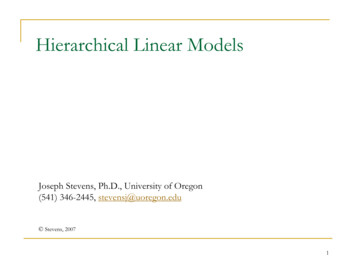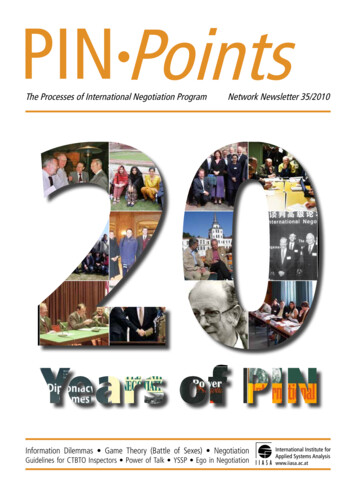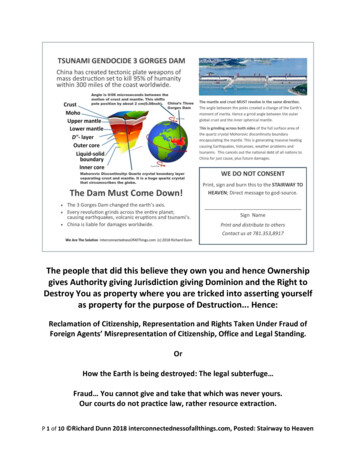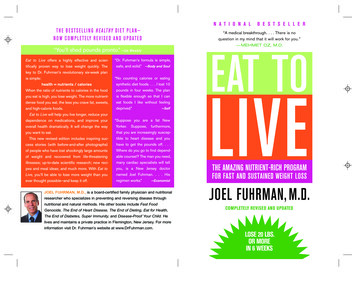
Transcription
Precursor to Genocide:A Study of Physicians in Nazi GermanyHillarie Huffman
PAGE2AbstractDuring the rise of Nazi Party, Germany was on the forfront of medical research.There was a founded fascination amongst doctors and scientists with genetics andevolution, which also coincided with the Nazi idea that some lives are unworthy of life.These ideas were developed in order to create a stronger Germany. The mentally andphysically disabled were seen as economic burdens and a health risk. The Nazisconsidered the extermination of this group a service to humanity. At the expense ofinnocent victims in concentration camps around Europe, German doctors would conductexperiments in order to find answers to their questions about racial superiority. In whitelab coats and with the resources to heal, Nazi doctors used their training instead to killunder the rouse of public health. During the Third Reich doctors in Germany disregardedtraditional medical ethics codes as a new form of medicine evolved with an emphasis ondestruction, which had full support of german doctors as well as there staff. Usinghistorical comparative analysis, my findings in both the research of the children'seuthanasia program and the T4 program, as wells as the morality of the euthanasia staff isthat the Nazis would do whatever it took to meet their goal of having a pure,homogenized state no matter how many people had to die.IntroductionThe topic of medicine in Nazi Germany has been carefully and thoroughlyresearched. Many feel that there are lessons to be learned from what happened to theunsuspecting, innocent victims who were killed because of their race, religion ordisability. While the literature is expansive, it is also contradictory. With many
PAGE3perpetrators as well as survivors no longer alive, we are left to decode their lives in orderto understand what really happened in those make shift hospitals. Beginning with highranking medical physicians such as Karl Brand and Josef Mengele, their life stories canreveal who they were before their experiences with the Nazi party and what happened tothem after. The purpose is to understand the "Nazification" of the medical profession.This particular profession is built on trust in physicians and their staff and we expectthem to be more compassionate. But during the time of Nazi Germany, doctors realizedthey could use the party to rise in rank. Doctors like Josef Mengele whose career wasbuilt on promotion of the party or Karl Brandt who used euthanasia centers aslaboratories. While the policies were accepted, this does not account for the enthusiasmthat these two doctors and many others had for their murderous occupations. Tounderstand this, my thesis will look into the early history of Josef Mengele and KarlBrandt as well as their later careers to better understand the impact of Nazi ideology ontheir lives.Perspectives of a LeaderIn order to understand the focus of medical practices in Nazi Germany, it isimportant to understand exactly what Adolf Hitler thought about the mentally ill andhandicapped as well as his feelings on the importance of medical research. In his book,Mein Kampf. Hitler details the problems with the current German leadership and how ithas allowed disease to take over the country (Hitler, 1943). He discusses creating a partysystem in which broader measures would be taken to rid Germany of disease (Hitler,1943). He blames the illnesses on the actions of German citizens and believes that the
PAGE4number of insane asylums has grown because of the growth of cities (Hitler, 248). Hitlerbelieved that a shift back into German rural culture would solve these problems. He alsooutlines his beliefs on the science of race. He states that mating outside of ones race inunnatural and therefore nature will act against them (Hitler, 1943).Hitler specifically discusses a group he calls the "incurables". In his book, hestates that killing them is a humanitarian effort (Hitler, 1943). He writes in Mein Kampf"the demand that defective people be prevented from propagating equally defectiveoffspring is a demand of the clearest reason and if systematically executed represents themost humane act of mankind. The passing pain of a century can and will redeemmillenniums from suffering" (Hitler, 1943). He believes handicapped or mentally illpeople are contaminating the healthy, and something should be done (Hitler, 1943).It seems that Hitler puts much of the blame of the downturn in German society onmentally ill and handicapped people. Because they are causing problems, they must go.He realizes that what he is saying may be shocking, so he adds that he will be sparingmillions of people who are undeserving of their life. As a whole, this will lead toimprovements in German health and moral overall (Hitler, 1943). Hitler looks to medicalresearch to create a superior society that will flourish and dominate the world.Medicine and the Nazi PartyFrom the beginnings of the Nazi party, doctors played a huge role. Doctors joinedthe Nazi party in greater numbers and earlier than any other professional groups. By1942, there were more than 38,000 doctors in the Nazi Party (Proctor, 1994). Importantinstitutes in Germany were focusing their resources on human genetics, which was a
PAGE5popular study in many other countries. This study helped provide "genetic registries" andtrain SS physicians (Proctor, 1994). The studies and experiments being done coincidedwith the ideology and future plans of the Nazi party. It seems that both the Nazi officialsas well as physicians, scientists and researchers came together because of the benefits.The Nazis wanted to rid Germany of "undesirables" and the doctors used this as anopportunity for research at a terrible cost to many innocent victims.EuthanasiaSterilizationEuthanasia in Nazi Germany began with forced sterilization. In 1933 lawmakerspassed the Law of Prevention of Offspring with Hereditary disease, which required allhandicapped individuals to be identified and allowed doctors to order involuntarysterilization (Baumslag, 2005). Suddenly it was the doctors who became the judges of thelaw. It was not long before sterilization became euthanasia. German scientist justified thisprogression by relating it to a functional burden (Baumslag, 2005). Before the war beganin 1939, Adolf Hitler explained to his staff his plan for the extermination of those whoselife was unworthy of living. Once the war began, so did the children's euthanasiaprogram.Philip Bouhler and Karl Brandt started the euthanasia program under the orders ofAdolf Hitler. This program, later named Aktion T4, was headquartered in Berlin and wasrun by 50 volunteer physicians (Braumslag, 2005). Over the course of the World War II,these doctors committed thousands of murders under a shroud of secrecy.Physicians and Other Killers
PAGE6Physicians were not the only people involved. Janitors, hospital managers andnurses also played a huge role in the euthanasia programs. The entire staff was forced tosign an oath of silence, but why did they (Friedlander, 235)? Henry Friedlander, author ofThe Origins of Nazi Genocide, cannot give one clear-cut answer, he seeks to point outseveral factors that effected the decisions and morality of the staff working in killingwards. It is clear that morally, the physicians saw these patients as threats to their societyand a problem they had to rid the nation of (Friedlander 235). Physicians and nursesworking in the T4 program perfected the technique of mass murder.To understand the euthanasia programs you must understand the complete processand the staff in its entirety. Without the staff, these atrocities would not have taken place.For the perpetrators of the T4 program, evidence is plentiful. The managers andsupervisors left a vast paper trail behind them (Friedlander, 1955). From lettersdescribing their duties to ordering more toxic gas, their participation in these crimes isobvious.For the most part, the managers of the eugenics programs were uninteresting andunimaginative. The chief perpetrators left the implementation up to the managers, whowere considered day-to-day bureaucrats. These men were not chosen because they hadexperience, but because they agreed with Nazi ideology and had been members beforetheir rise to power (Friedlander, 1955). They had proved, through their unyieldingsupport for the Nazi party, that they were willing to participate in this killing enterprise.There were some managers who left the T4 program, but there is no proof that they leftfor moral reasons (Friedlander, 1955).
PAGE7Paperwork from these managers proves that they knew what was going on andwhat they were doing. They knew that they were killing people from their desksalthough; they never saw their victims (Friedlander, 1955). Some believe that thesemanagers were under peer pressure and that is why they committed the crimes. Theywere clearly not under duress and had not been coerced. Their careers were important tothem and they saw this as moving their way up the ladder of Nazi bureaucracy(Friedlander 1955). While it is hard to believe, it seems that these men participated in theeugenics program to advance their careers.Killing & Killing CentersThe Technology of the killing centers is essential to understanding the euthanasiaprogram as a whole. The killing centers, however, were never used for medical purposes.In fact, the Nazis were the inventors of the gas chamber. Eventually six killing centerswith gas chambers were established (Friedlander, 1955).The gas chambers were equipped to appear as shower rooms with shower headsand benches for patients to sit on. They were also equipped with mobile ovens, whichwere attached to a chimney (Friedlander, 1955). Every procedure that the operators of thegas chambers went through was made to cover up the killing function of the killingcenters. Patients were efficiently processed and lead to their death sometimes withintwenty-four hours (Friedlander, 1955). By the end of 1941, at least 70,000 patients hadbeen murdered and the disguise of the killing centers as hospitals had been ripped away.While a public outcry stopped the mass killings in gas chambers (for the most part), thekilling continued in the form of injections and starvation (Baumslag, 2005). Euthanasia
PAGE8was still happening, but the process was made slower as to better conceal the killingsfrom the public.Dr. Karl BrandtBorn in Mulhausem, Brandt would play a major role in the implementation of thefirst mass killing program in Nazi Germany. He would later become the GeneralCommissioner for Health and Sanitation and would be the foremost medical authority inthe Third Reich. He was a rational medical scientist and possessed a fascination for racialeugenics, mysticism, ancient civilization and romanticism. He was part of generation thatwas born between 1900 and 1910, who experienced WWI as children and would lateradvance to key positions. This group was highly ambitious, yet had little empathy for thesuffering of others. According to Ulf Schmidt in Karl Brandt: The Nazi Doctor, in hisadolescence, Karl Brandt had experienced not only the First World War but alsoeverything else that came with the defeat of Germany. The Versailles Treaty, Alliedreparations, and economic hardship had a huge impact on his life. During his time inmedical school in Jena, Berlin, Munich, and Freiburg imp Breisgau, his knowledge onmedical ethics was shaped by political debates on eugenic, compulsory sterilization, andracial hygiene (Schmidt, 2005). The politics of the time began to change the wayphysicians perceive life. Generally, we think of physicians wanting to preserve life, but itappears that death had become a part of Brandt's overall belief. He thought that the deathof the patient not only delivered them from pain and suffering, but also freed physiciansand society from the expense of caring for them (Schmidt, 2005). Throughout his career,Brandt would lose sight of the individual. In his defense, Brandt wanted to portray
PAGE9himself as believer in mercy killing and otherwise had been ignorant of other crimes ofthe regime. He wanted the courts to believe he had simply fallen victim to the politicalmovement. At Nuremburg, he portrayed himself as a responsible doctor, emphasizing thequality of the idea of the euthanasia program. However, he would not acceptresponsibility for those who turned his 'honest idea' into medical atrocities (Schmidt,2005).Karl Brandt was born on January 11,1904 to Karl Julius Brandt and CatherinaBrandt. The family was declared in records to be of protestant faith (Schmidt, 2005). Hespent his youth in Mulhausen, which is one of the most densely populated areas ofEurope. Until the age of nine, Brandt attended the Volksschulen before he went tosecondary school (Schmidt, 2005). Brandt would describe his relationship with hisparents as 'completely balanced' (Schmidt, 2005). He appeared to have a goodrelationship especially with his father during his youth. In 1913 he joined theWandervoge 1 youth movement. This organization promoted traditional values and anatural lifestyle for young people. He left the organization in 1919 when his familymoved to Germany (Schmidt, 2005). After France, as part of he Versailles Treaty, hadannexed Alsace; Brandt and his mother moved to Thuringia. Because of the war, likemany young men at the time, Karl Brandt felt uprooted by the war and in need oforientation because of WWI. He tried to compensate for these feelings by study of theBible and attachment to the Lutheran Church (Schmidt, 2005). He was attracted to thecharitable works of the Lutherans and hoped take part.In 1920, Brandt was enrolled in Unter-Secunda at the secondary school(Schmidt, 2005). He struggled with this however, because he had only been taught
PAGE10French and now had to catch up. During this time, his family moved to Dresden where heeventually passed his Abitur (Schmidt, 2005). He was still dealing with the psychologicalconsequences for losing the war, which included the financial instability his parents nowfaced. His father had served as an officer in the Imperial army and was released from aFrench prisoner of war camp. He was part of a group of demoralized soldiers, who felthumiliated and betrayed by their country (Schmidt, 2005). Seeing his father in theposition would influence Brandt's political attitude in his later career. This also may haveinfluenced his father to send him to a former cadet school. The school was located in thestate of Saxony and was meant to instill a certain sense of discipline and loyalty in theyoung men who attended (Schmidt, 2005). At the age of nineteen, Brandt passed hisAbitur at the cadet school. It is noted that Brandt was interested in religion, Germanhistory, and geography. However, he was less interested in other cultures and languages,and revived poor marks in classes such as French and Latin (Schmidt, 2005).His later years in medical school would prove that he was an ambitious youngman who wanted a career as a physician. In fact, his decision to study medicine wasobvious. According to Schmidt, his mother's side of the family was made up of doctorsand it was assumed that he would continue the tradition (2005). From May 1923 to April1925, he studied medicine at the University of Jena (Schmidt, 2005). It is well known thatJena was a popular place of anti-Semitic currents during this time, however there is noindication that Karl Brandt was involved in any of these activities. Unlike other Naziofficials, Brandt's rise to power was not preceded by political activity in the 1920s and1930s. Prior to 1945 there are no statements concerning his political or ideological views
PAGE11(Schmidt, 2005). Because of this, to truly understand the role he played in killingthousands of mentally ill people, we must look at what he did, not what he said.In 1925 he completed four terms along with his medical exam and thus, hiscareer began. During his subsequent training he worked with leading experts in the field.It was here that he was introduced to the heated debates over evolution, racialdegeneration, and eugenics. Although there was widespread anti-Semitism amongst hiscolleagues, there is no record of Brandt publicly voicing his opinion (Schmidt, 2005).Perhaps since he was interested in climbing the career latter, he was less interested in thepolitics swirling around him and more on his studies.In Frieburg Brandt was introduced to the contentious issue of euthanasia. Hefinished his studies at the University of Frieburg in 1928 and on October 19,1929 theuniversity conferred the degree of doctor for Brandt (Schmidt, 2005). During his trainingas a doctor, he gained experience in understanding the suffering of patients withdisabilities. This must have strengthened his belief in the justification of euthanasia.During his work as an apprentice for Mangus, the head of the surgical department, Brandtwas exposed to seriously ill patients. Some of them even approached him about endingtheir own lives (Schmidt, 2005). This experience must have convinced Karl Brandt thatin the most severe cases it was in the patient's best interest to die. From Frieburg, Brandtwould move to several more hospitals where he gained more experience. He also madeconnections with Albert Schweitzer around 1932, which almost convinced Brandt intogoing to Africa to help those in need (Schmidt, 2005). Many parts of this trip could haveinfluenced Brandt. Perhaps it was the sense of charity or maybe it was an attempt todiscover him. However, national pride stopped him from going. He would have been
PAGE12required to serve in the French army, which was unacceptable for him because his fatherhad been in a French prison of war (Schmidt, 2005). Never the less, if Brandt cold notfollow Schweitzer, he would follow Hitler.Brandt claimed to be have joined the Nazi Party as early as 1926, but this cannotbe validated. At the beginning, it seems that Brandt was unsure of whether to publiclysupport the Nazis. He was not certain if or how the Nazi could advance his career whichwas his biggest concern. Never the less, he agreed to serve as a medical doctor for the SAand SS. He only became a party member after he met his wife, Anna Rehborn. She hadbeen in contact with the party and with Adolf Hitler for some time (Schmidt, 2005).Because of this Brandt began to make tactical moves concerning the Nazi party.According to Schmidt, he joined the SA in 1933 (2005). Shortly after, luck struck forKarl Brandt in the form of an automobile crash. Hitler witnessed Brandt provide promptmedical care after a car in Hitler's entourage crashed (Schmidt, 2005). At the time Hitlerwas looking for loyal servants as his political and personal advisors and Brandt wasanxious to become part of Hitler's inner circle. With time, Brandt would indeed becomepart of the inner circle as well as a personal physician to Hitler.In 1939 Brandt was entrusted by Hitler to organize and implement the euthanasiaprogram. Karl Brandt would be a cofounder along with Phillip Bouhler, head of theChancellery of the Fuhrer (Schmidt, 2005). The literature suggests that the programevolved haphazardly without any real guidelines from the state. Brandt took charge of allof the medical aspects or the program while Bouhler handled the administrative side(Schmidt, 2005). Karl Brandt was in charge of selecting medical experts and made thedecision about the actual killing method. He realized that he would be killing tens of
PAGE13thousands of people and that the method would need to be fast and inconspicuous. Afteran experimental test on patients, Brandt decided that gas would be the most 'humane'way to euthanize the patients. As the euthanasia program continued to gain speed, KarlBrandt began to detach himself from the day-to-day running of the operation. During myresearch, I have gained the impression that Karl Brandt was a cold man. It was notuncommon for most of the SS men to repress their own feelings in order to detachthemselves from reality. The available material made it possible to speculate aboutBrandt's personality, but not much more. The entire program was run in secrecy andBrandt's only concern was that there was no official law (Schmidt, 2005).In 1941 the euthanasia program was halted as concerns by the public mounted.Suddenly, Karl Brandt's role switched from head of the euthanasia program to Hitler'srepresentative in asylum matters, which greatly hampered his sphere of influence(Schmidt, 2005). From there, his career would continue to fall apart as the war came to anend. As the Red Army approached, Brandt attempted to leave Berlin with his family butwas captured by and imprisoned by the German police. The biggest question is whetherKarl Brandt was connected to the extermination of the Jews Eastern Europe. While theevidence is inconclusive, the fact that Brandt was in almost constant communication withHitler implies that he may have assisted.A lot can be learned through the testimony of Karl Brandt during the Nuremburgtrials. He is immediately identified as a key player in the Nazi eugenics program,although he denies it (Wiendling, 2004). He claims that he is a genuine advocate formercy killing. He considers the handicapped, deformed and mentally ill as suffering andas burdens to the German war machine (Wiendling, 2004). These people were getting in
PAGE14the way of an ideal German nation. It is clear that Brandt is a believer of the euthanasiaprogram and that his involvement was key in the design of the Nazi euthanasia program.The Nazi euthanasia program was labeled a war crime because of a secret decreegiven by Hitler to implement the program came in 1941, the same year that Poland wasinvaded by the German army (Wiendling, 2004). The prosecution argued that thisprogram was a precursor of genocide. The strategy of the prosecution was to "attack Nazimedicine as inefficient, unscientific and monumentally destructive"(Wiendling, 2004).The defense argued that Nazi leaders were simply implementing a program that waspopular among citizens (Wielding, 2004). Karl Brandt cites a petition that was sent toHitler by a family who begged that their child, who was considered incurable, be killed(Wiendling, 2004).The second defense was based on the fact that the doctors performing the killingsexamined patients on a case-to-case basis (Wielding, 2004). The reality of this is that thedoctors made their decisions to kill based on a hastily written, inaccurate document(Wiendling, 2004). They never examined the patient face to face. Karl Brandt is quotedas saying "Every individual doctor was responsible for what he did in the course of thosemeasures which led to Euthanasia. Each doctor was absolutely responsible for hisjudgment"(Wiendling, 2004). The charge of conspiracy to commit neither euthanasia northe design could be proven. In the end, the trial failed in its attempt to prove the origins ofthe program, however Karl Brandt was convicted of war crimes and was sentenced todeath by hanging.Medical Experimentation
PAGE15Leaders within the Nazi party, especially Hitler, encouraged experimentationamong doctors who carried out their plans. Part of Nazi ideology was to purge the nationof any elements that were considered undesirable. Because of this idea, many of theencouraged experiments were based on eliminating elements that could be harmful tosociety. Doctors of the Nazi regime are infamous for their cruel experiments. Some ofthe experiments were ordered by Nazi officials for specific ideological purposes, othershowever were done out of pure interest of the SS doctors. Nevertheless, the interests ofboth the SS doctors and the state would overlap. Doctors changed their oath of allegiancefrom their ethical code to Hitler. In Nazi Germany, the attempt by physicians to cure wasalso a way to kill and injure. Thus, the reason for such an array of experimentationincluding experiments on the effects of drinking seawater, experiments with the ingestionof poison, experiments with artificially created typhus, experiments with cold waterimmersion, experiments with mustard gas, experiments with the regeneration of bone,and many others (Lifton, 1986). These are only a few examples of the cruel methodsinflicted on unwilling victims in concentration camps. The experimentation, especially atAuschwitz, represents a removal of medical limits. These experiments were done tocomplete the Nazi medical vision of having a pure, homogenized race.AuschwitzAuschwitz is well known as an epicenter for medical research and infamous forcruel experimentation. For example, an infamous experiment was don by Carl Claubergand Horst Schumann, who were officially directed to take the blood from prisoners withactive typhus and directly inject it into healthy prisoners. This was done to find a solutionto the outbreak of Typhus among German troops fighting on the eastern front (Lifton,
PAGE161986). Experiments such as these were a part of normal everyday life for many of thevictims detained in this concentration camp and many others.It in particular, Auschwitz was open to any type of killing, but this openness ledto gruesome experimentation on every level. Many rising doctors, who wished to moveup the professional ladder, volunteered to be sent to Auschwitz and were eager to gainsurgical experience (Lifton, 1986). As the boxcars rolled in, there was an unlimitedsource of victims for research of any kind. The SS doctors were able to gain medical filesfor victims with specific ailments or diseases and would have them report to the hospital(Lifton, 1986). The victims were seen as an unlimited supply of bodies for doctors topractice on. Without any supervision from experienced doctors, they would attemptcomplex operations on unwilling patients.Prison DoctorsSoon, prison doctors were pulled into this experimental world. While many ofthem assisted in experiments of SS doctors willingly or un-willingly, they developed acode in an attempt to save lives. The prison doctors would avoid reporting results thatcould lead to the death of an inmate (Lifton, 1986). The only healing they were capablewas in falsifying documents to save lives. In fact, almost half of concentration campsurvivors owe their life to a prison doctor (Baumslag, 2005). The so-called hospitals theyworked in were disgusting and lacked any basic equipment. Why there were hospitals atall is unclear. It is clear that the prison doctors serving in concentration camp serve as asmall example of ethical practice in dreadful places.
PAGE17Dr. Josef MengeleFrom ambitious student to Angel of Death, Dr. Josef Mengele rose through theranks of the Nazi party to become one of today's most well known perpetrators ofinhumane medicine. In his book Mengele, Gerald Posner describes a young boy growingup as the eldest of three sons. His parents, who were devout Catholics, raised theirchildren with strictness and discipline (Posner, 1986). From a young age, Josef wasbedded often with several childhood diseases. In The TastNari Gerald Astor relates thisisolation to an inability for Mengele to truly relate to others (Astor, 1985). He chose notto take up the family business at the foundry, which manufactured farm equipment.Instead, Josef Mengele was interested in other things especially in the subjects ofzoology, biology, physics and anthropology (Posner, 1986). From an early age it wasclear that he possessed a searing ambition.Living in the Mengele home meant respect rather than affection. Only 16 monthsolder than his two brothers, Josef felt a constant since of competition growing up (Posner,1986). The relationship between his parents did not improve the austerity in the homeeither. They were known to be a quarrelsome pair. He described both of his parents ascold and unloving. A nanny called Monika fulfilled the maternal role that Josef Mengelelonged for. She also encouraged him to hold fast to the Catholic faith (Schmidt, 1986). Itwas the strictness of the Catholic religion that made him turn away from it in his laterlife.In April 1930 he passed his high school Arbitur with exceptional grades. Becauseof his interests, he went on to pursue studies of anthropology and medicine at MunichUniversity in 1930. At this time in his life, he showed no real interest in the vast political
PAGE18changes that were going on around him. Although, he did join the Stahlhelm (Steelhelmets) in 1930, he was more focused on his studies (Posner, 1986). It did not takemuch time, however, for Josef Mengele to realize that joining the ever-popular Nazi partycould pay off. It is interesting that Mengele, from the beginning, was more concerned onwhat the Nazi party could offer him than because of his political ideology. According toPosner, there is no totally clear answer as to why Mengele's mind was corrupted by theNazi party. His medical research did correspond with the interest in genetics andevolution of the Nazi party (1986). He became very interested in cultural origins of manrather than curing illnesses. During his time in Munich and later at Frankfurt, Mengelewould study under the leading advocates for the 'unworthy life' theory (Posner, 1986).Suddenly in January 1934 a kidney infection had forced him to leave theSturmabyeilung, which had been ordered by Hitler to absorb Stalhelm (Posner, 1986).This illness left him weak and frail, but gave him an opportunity to concentrate on hisstudies alone. Soon, Mengele took and passed his state medical examination. Thisallowed him to get his first paying job at the university medical clinic. This was also theplace where he would meet his future wife, Irene Schoenbein (Posner, 1986). His hardwork at the clinic paid off as he was referred to a position as a research assistant at theThird Reich Institute for Heredity, Biology, and Racial Purity at the University ofFrankfurt (Posner, 1986). This him right in the epicenter of Nazi sci
program. Philip Bouhler and Karl Brandt started the euthanasia program under the orders of Adolf Hitler. This program, later named Aktion T4, was headquartered in Berlin and was run by 50 volunteer physicians (Braumslag, 2005). Over the course of the World War II, these doctors










